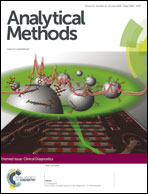Synergistic fluorescence quenching of quinolone antibiotics by palladium(ii) and sodium dodecyl benzene sulfonate and the analytical application
Abstract
In weakly acidic and neutral media, palladium(II) or sodium dodecyl benzene sulfonate (SDBS) can separately quench the fluorescence of quinolone antibiotics (FLQs) in varying degrees. When Pd(II) reacts with SDBS and FLQs to form ternary complexes, enhanced fluorescence quenching of FLQs can be observed. This synergistic fluorescence quenching effect has high sensitivity for Pd(II) detection, and the detection limit could reach 0.13 ng mL−1. Based on this, a rapid, simple and reliable method for the determination of Pd(II) in aqueous samples was established. The optimum reaction conditions of the method were tested. The reaction information of the FLQs–SDBS–Pd(II) system was investigated by absorption spectra and fluorescence spectra, and quantum chemical calculations using density functional theory B3LYP under a polarizable continuum model (PCM). The results showed that the pefloxacin (PEF) molecule exists as a zwitter-ion of HL±, reacting with Pd(II) to form plane bis(PEF)Pd chelates, which further bind with two SDBS molecules to form ternary complexes. The composition of Pd(II)–PEF–SDBS complex was found to be 1 : 2 : 2. The ternary complexes resulted in a higher fluorescence quenching efficiency and enhanced the sensitivity for the determination of Pd(II).


 Please wait while we load your content...
Please wait while we load your content...